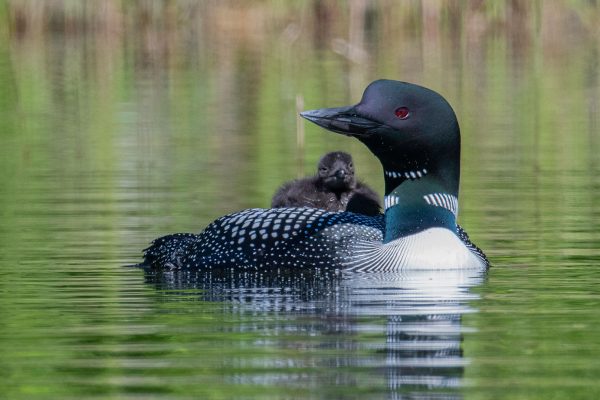
Common Loon and baby. Photo by Gerard Monteux
Common Loon
Gavia immer
Cool Fact: In the non-breeding season when they are on the ocean, loons show modest gray upperparts and white underparts, but in the summer months (breeding season) adults have a striking black and white neck and back, and a black head and bill.
Common Loons are among Maine’s most beloved and iconic birds, known by summer lake enthusiasts for their loud, wailing calls and their handsome black and white checkerboard breeding plumage. They have an extensive breeding range across Canada and Alaska, reaching their southern limits in Maine and other northern U.S. states. Adept in the water but not on land because their legs are located far back on the body, the birds build nests very close to the shore so they can get on and off them quickly from the water. Unfortunately, this means that the nests can also be very vulnerable to changes in water levels and to wave action from boats passing at higher speeds.
Common Loons switch in winter to being marine birds, spending the non-breeding season along the Atlantic and Pacific Coasts of Canada, the U.S., and Mexico and along the Gulf Coast of the U.S. Common Loons change color depending on the season. In the non-breeding season when they are on the ocean (roughly September to March), loons show modest gray upperparts and white underparts, but in the summer months (breeding season) adults have a striking black and white neck and back, and a black head and bill.
Common Loons feed primarily on fish, but they also feed on other aquatic animals including crayfish in freshwater and crabs in saltwater. The loons’ impressive fishing skills are propelled by feet that sit at the rear of its body and the ability to stay underwater for minutes at a time.
Common Loon populations appear to be relatively stable over their entire range so that it is relatively lower on the Continental Concern Score, a metric of the conservation threats different birds in the U.S face. Lead fishing sinkers remain a threat to the species, as they can cause lead poisoning, and loons occasionally get caught in fishing nets. Healthy freshwater and marine ecosystems are essential for the long-term survival of Common Loon populations.
—by Lucia Pizarro and Allison Wells
Banner photo: Common Loon on Brettun’s Pond, Livermore, Maine, by Ted Anderson










